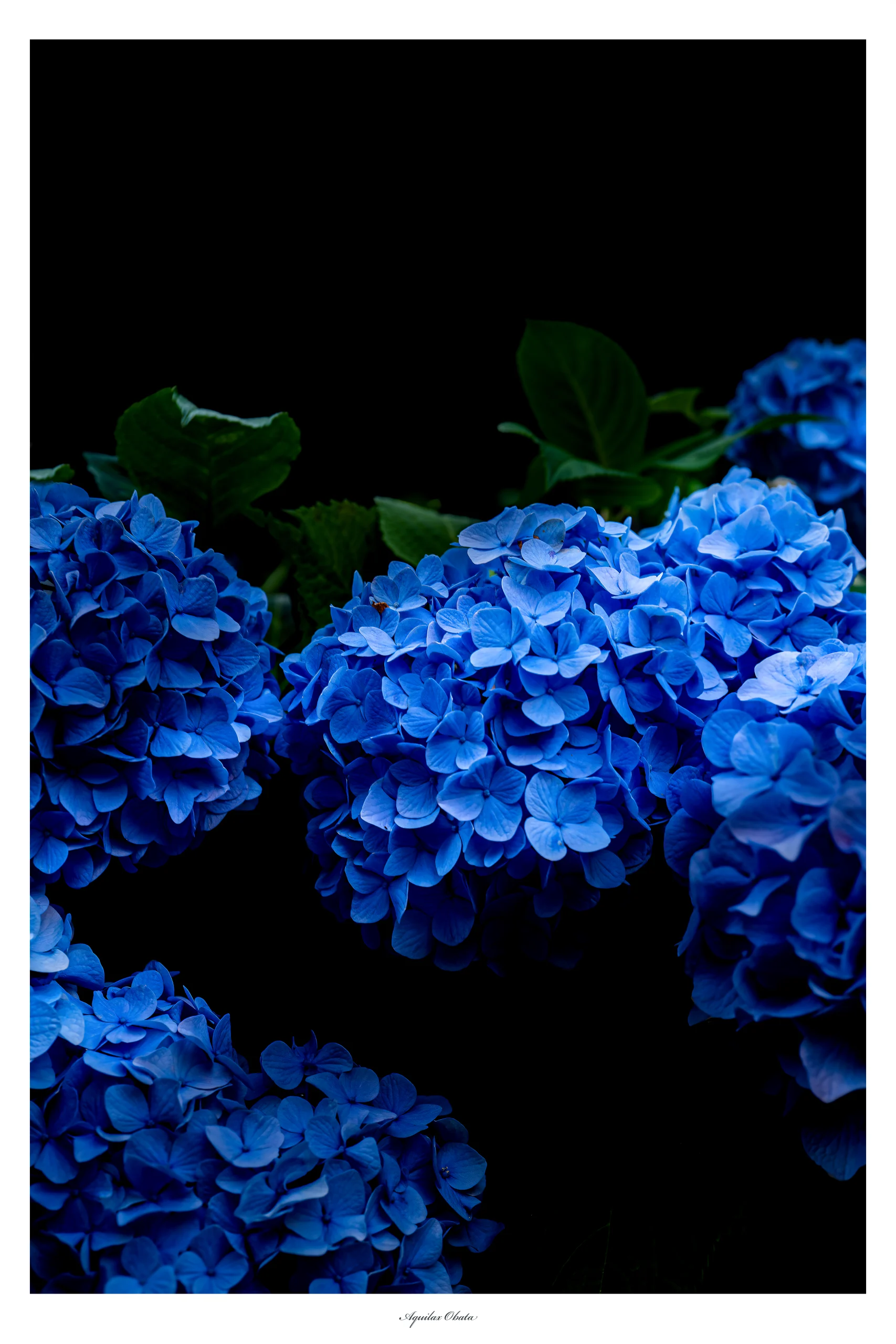INDEX
From monochrome to colour
For the first time in a long time, I was completely blown away by the incredible blue of hydrangeas. I decided to abandon monochrome and use colour to express the beauty of this stunning blue.
I wonder if I used too many contrast setting values on my camera?
It was cloudy, evening and in the shade, so the blue seemed stronger than it actually was overall.
For me, this is what I love about the blue of hydrangeas, or so I think.
Location of Meigetsuin Blue
This hydrangea was photographed in the precincts of Meigetsuin Temple in Kitakamakura, Kamakura, Kanagawa Prefecture, which is known as the Hydrangea Temple.
This is an old and beloved temple that I have photographed many times during this season.
During the hydrangea season, many tourists fill the roadsides and precincts, making it difficult to concentrate and focus the lens on the hydrangeas.
It was a weekday. We entered the temple gate 30 minutes before it closed. It had rained occasionally the day before and again on this day. We thought there would be few tourists.
As predicted, we were able to take photos in a relatively calm atmosphere.
Hydrangeas vary in colour according to growing conditions and variety, such as pink, white and blue. I was looking for deep blue.
The area around Myogetsuin is located in a wetland valley called a valley door, which means that the soil is acidic and the aluminium in the soil easily dissolves due to the high water content in the soil. This combines with the anthocyanins in the flowers to produce a deep blue colour.
They show a rich blue with gradations, especially if it rained the day before or under cloudy skies.
The time of day is also important for photography. If possible, the ideal time is just after sunset or just before sunrise, when the light is softer, but this is difficult to achieve due to the opening and closing times of temples.
Reproducing the blue hour on the camera side
Therefore, we decided to create a pseudo time zone by adjusting the camera settings closer to the conditions of the blue hour. Contrast, highlights, shadows and colour tones are adjusted, and to create a sense of airiness, settings such as sharpness and grain are fine-tuned to achieve results close to the image. These settings are roughly determined on the train before arriving at the station in Kitakamakura.
Many hydrangea temples in Kamakura
Hydrangeas are known for their ability to take root widely and deeply in soil. This makes them an excellent choice for slopes, as they can help prevent landslides.
I have had the pleasure of riding the Hakone Tozan Railway with my children. It is not only a beautiful journey, but it also has many hydrangeas planted along the steep slope of the railroad line. This not only adds to the beauty of the journey, but it also protects the line from landslides caused by heavy rains throughout the year.
The temple grounds, situated in a mountainous area and extending along a valley, offer a variety of shaded areas, which provides an ideal environment for hydrangeas to flourish.
What will happen next year?
Having reached the age of what is called ‘elderly’, I wonder how long I will be physically able to carry heavy equipment and take photographs?
Kamakura is dotted with many places famous for their hydrangeas, but this is the only photo I took this year. I don’t know if I will be able to try again next year.
photograph

モノクロからカラーへ
紫陽花の美しい青に魅せられ、今日はモノクロームを放棄してカラーで自分の青を表現しました。
カメラのコントラスト設定値を多くしすぎたかな?
曇り空、夕刻、日陰だったので、実際より若干、青が強くなったようです。
しかし私にとって紫陽花の青はこれで良い、そう思っています。
明月院ブルーの立地条件
この紫陽花を撮影したのは神奈川県鎌倉市、紫陽花寺と呼ばれている北鎌倉の明月院の境内です。
この季節、何度となく撮影してきた古刹、愛着あるお寺です。
紫陽花の季節になると多くの観光客が沿道や境内を埋め尽くし、気持ちを集中して紫陽花にレンズを向けることが困難な場所です。
この日は平日。寺の門が閉まる30分前に山門を潜りました。前日そしてこの日も時折雨が降り。観光客も少ないだろうと考えてのことでした。
予測通り、比較的穏やかな雰囲気の中で撮影できました。
紫陽花はピンク、白、青など栽培条件や品種によって色が異なります。私が求めていたのは深い青です。
明月院一帯は谷戸と呼ばれる谷間の湿地にあるため、土壌が酸性、土に水分が多く土壌に含まれるアルミニウムが溶けやすい。花に含まれるアントシアニンと結合して深い青を発色します。
特に前日が雨、曇り空の下では階調の豊かな青を見せてくれます。
カメラ側でのブルーアワーの再現
写真撮影には時間帯も重要です。可能であれば光が柔らかい日没直後、日の出直前の「ブルーアワー」が理想的ですが、お寺の開門、閉門時間の関係からそれは難しい。
そこでカメラの設定値をブルーアワーの条件に近づけて擬似的に時間帯を作り出すことにしました。コントラスト、ハイライト、シャドウ、色調を調整、空気感を出すためにシャープネス、粒状などの設定値を細かく設定して、イメージに近い結果が得られるよう調整します。これらの設定は北鎌倉の駅に着く前、電車の中で大まかに決定しておきます。
鎌倉に多い紫陽花のお寺
紫陽花は土の中に広く深く根を張る植物です。斜面に植えられた紫陽花は土砂崩れを防ぐ役割をしてくれます。
子供達を連れて箱根登山鉄道に乗ったことがありますが、急勾配の路線沿いにはたくさんのアジサイが植えられ、梅雨時は乗客の目を楽しませてくれるだけでなく、通年通して大雨による土砂から線路を守る役目も兼ねているわけです。
山地に囲まれ、谷地を這い上がるように広がるお寺の境内には、日陰地が多く、紫陽花にとって絶好の環境だといえます。
来年はどうなることか?
後期高齢者と呼ばれる年齢に達し、重い機材を携えての撮影が体力的にいつまで可能かどうか?
鎌倉には紫陽花の名所が多く点在しますが、今年はこの一枚限りです。来年再びチャレンジできるかどうか、それは分かりません。